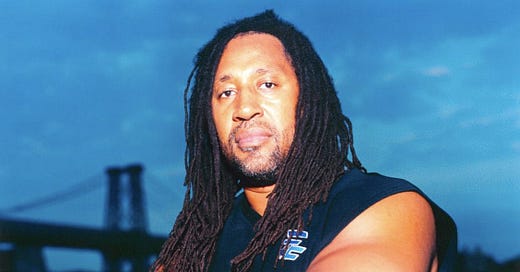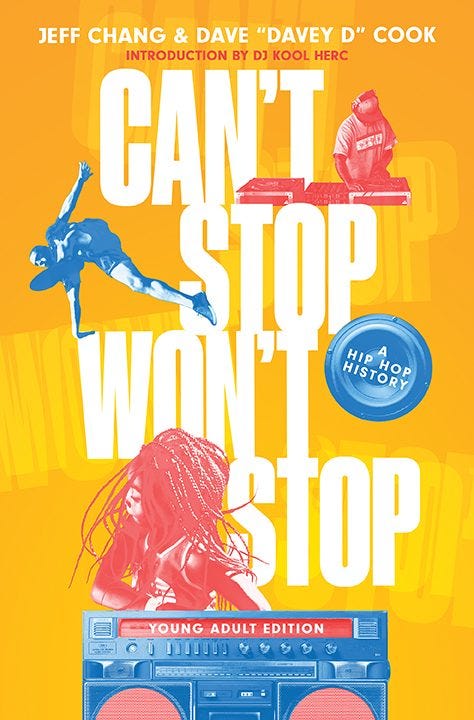DJ Kool Herc in New York City, 2002. Photo credit: Marlon Ajamu Myrie, ajamuphoto.com
August 11, 1973
The night of DJ Kool Herc and Cindy Campbell’s back-to-school party in their West Bronx apartment building rec room.
The date many of us have been marking as the birth of hip-hop.
Maybe it’s a fool’s errand to try to name a single exact moment when it all began. Serious students of the culture can point in many different directions to many different events and movements. Most of them would be right.
We can all agree that hip-hop did not start with a manifesto. There was never an explicit call to change the world — the way many other movements start.
Hip-hop began simply as a way for abandoned Black and brown youths to have fun.
But because they made it, we now know that 50, 49, 150, however many years later — hip-hop has changed the world.
So while some may disagree about exactly who and exactly when, most of us agree that what really matters are the What and the Why.
The What: Hip-hop is just the latest manifestation of Black freedom culture. The Why: it's about everyone’s liberation.
To paraphrase Bob Marley — some are leaves, some are branches, but we all have to respect the roots.
So here’s an excerpt from Can’t Stop Won’t Stop: A History of the Hip-Hop Generation and Can’t Stop Won’t Stop: A Hip-Hop History – The Young Adult Edition about that evening of August 11, 1973 and what made it so special.
Giving thanks for those who made it happen and all of you all who continue to make it happen…Celebrate hip-hop’s 50th this weekend!
DJ Kool Herc at Stafford’s Place club, Bronx, NY. Mid-1970s. Photo credit: Christie’s
It has become myth, a creation myth, this West Bronx party at the end of the summer in 1973. Not for its guests—a hundred kids and kin from around the way; nor for the setting— a modest recreation room in a new apartment complex; not even for its location — two miles north of Yankee Stadium, near where the Cross-Bronx Expressway spills into Manhattan. Time remembers it for the night DJ Kool Herc made his name.
The plan was simple enough, according to the party’s host, Cindy Campbell. “I was saving my money, because what you want to do for back to school is go down to Delancey Street instead of going to Fordham Road, because you can get the newest things that a lot of people don’t have. And when you go back to school, you want to go with things that nobody has so you could look nice and fresh,” she says. “At the time my Neighborhood Youth Corps paycheck was like forty-five dollars a week—ha!—and they would pay you every two weeks. So how am I gonna turn over my money? I mean, this is not enough money!”
Cindy calculated it would cost a little more than half her pay- check to rent the rec room in their apartment building at 1520 Sedgwick Avenue. Her brother, whom she knew as Clive but everyone else knew as Kool Herc, was an aspiring DJ with access to a power- ful sound system. All she had to do was bulk-buy some Olde English 800 and Colt 45 malt liquor, hot dogs, and buns, and advertise the party.
She, Clive, and her friends hand-wrote the announcements on in- dex cards, scribbling the details of the time and location below a popular song title like “Get on the Good Foot” or “Fencewalk.” If she filled the room, she could charge a quarter for the girls, two for the guys, and make back the overhead on the room right there. And with the profit—presto, instant wardrobe.
Cindy Campbell, 1974 and 2022. Photo credit: Christie’s
Clive had been DJing house parties for three years. Growing up in Kingston, Jamaica, he had seen the sound systems firsthand. The local sound was called Somerset Lane, and the selector’s name was King George. Clive says, “I was too young to go in. All we could do is sneak out and see the preparation of the dance throughout the day. The guys would come with a big old handcart with the boxes in it. And then in the nighttime, I’m a little itchy headed, loving the vibrations on the zinc top ’cause them sound systems are powerful.” He wanted to be at the center of that kind of excitement, to be exactly like King George.
Cindy and Clive’s father, Keith Campbell, was a devoted record collector, buying not only reggae, but American jazz, gospel, and country. They heard Nina Simone and Louis Armstrong and Nat King Cole, even Nashville country crooner Jim Reeves. “I remember listening to Jim Reeves all the time,” Clive says. “I was singing these songs and emulating them to the fullest. That really helped me out, changing my accent, is singing to the records.”
In the Bronx, his mother, Nettie, would take him to house parties, which had the same ambrosial effect on him that the sound systems had. “I see the different guys dancing, guys rapping to girls, I’m wondering what the guy is whisperin’ in the girl’s ears about. I’m green, but I’m checking out the scene,” he recalls. “And I noticed a lot of the girls was complaining, ‘Why they not playing that record?’ ‘How come they don’t have that record?’ ‘Why did they take it off right there?’” He began buying his own 45s, waiting for the day he could have his own sound system.
As luck would have it, Keith Campbell became a sponsor for a local rhythm and blues band, investing in a brand-new Shure P.A. system for the group. Clive’s father was now their soundman, and the band wanted somebody to play records during intermission. Keith told them he could get his son. But Clive had started up his own house party business, and somehow his gigs always happened to fall at the same times as the band’s, leaving Keith so angry he refused to let Clive touch the system. “So here go these big columns in my room, and my father says, ‘Don’t touch it. Go and borrow Mr. Dolphy’s stuff,’” he says. “Mr. Dolphy said, ‘Don’t worry Clive, I’ll let you borrow some of these.’ In the back of my mind, Jesus Christ, I got these big Shure columns up in the room!”
DJ Kool Herc with the one of those Shure columns, aka the Herculoids, 1977. Photo credit: Christie’s
At the same time, his father was no technician. They all knew the system was powerful, but no one could seem to make it peak. Another family in the same building had the same system and seemed to be getting more juice out of it, but they wouldn’t let Keith or Clive see how they did it. “They used to put a lot of wires to wires to distract me from chasing the wires,” he says.
One afternoon, fiddling around on the system behind his father’s back, Clive figured it out, even the echo function. “Myfather came home and it was so loud he snuck up behind me,” he remembers.Clive’s guilt was written all over his face. Buthis father couldn’t believe it.
Keith yelled, “Where the noise come from?”
“This is the system!”
Keith said, “What! Weh you did?”
“‘This is what I did,’” Clive recalls telling his father, revealing the hookup. “And he said, ‘Raas claat, man! We have sound!!!’
Mike Mike with the Lights, Timmy Tim, Coke La Rock, DJ Kool Herc, and Diamond D at Riverside Projects, Bronx. Photo credit: Christie’s
It was a Saturday, the 11th of August, 1973. Cindy, Clive, and their friends brought the equipment down from their second-floor apartment and set up in the room adjacent to the rec room. “My system was on the dance floor, and I was in a little room watching, peeking out the door seeing how the party was going,” he says.
It didn’t start so well. Clive played some Jamaican reggae tunes, ones guaranteed to rock any yard dance. Like any proud DJ, he wanted to stamp his personality onto his playlist. But this was the Bronx. They wanted the breaks. So, like any good DJ, he gave the people what they wanted, and dropped some soul and funk bombs. Now they were packing the room. There was a new energy. DJ Kool Herc took the mic and carried the crowd higher.
“All people would hear is his voice coming out from the speakers,” Cindy says. “And we didn’t have no money for a strobe light. So what we had was this guy named Mike. When Herc would say, ‘Okay, Mike! Mike with the lights!’ Mike flicked the light switch. He got paid for that.”
By this point in the night, they probably didn’t need the atmospherics. The party people were moving to the shouts ofJames Brown, turning the place into a sweatbox. They were busy shaking off history, having the best night of their generation’s lives.
Later, as Clive and Cindy counted their money — they had made three hundred dollars! — they were giddy. This party could be the start of something big, they surmised. They just couldn’t know how big.
There are two US editions of Can’t Stop Won’t Stop – the original award-winning 2005 book and a Young Adult edition from 2021 co-written with Davey D that updates the story from Black Power to Black Lives Matter. Jeff and Davey also voice the audiobook. Find out more about them here: cantstopwontstop.com
Check Davey D on Instagram at @mrdaveyd and tune in to Hard Knock Radio, every weekday afternoon on Pacific radio.
MORE ON
HIP-HOP’S 50TH!
READ: Medium - How Hip-Hop Got Its Name
An oldie but goldie from deep in the archives.
READ/LISTEN: National Public Radio - 50 years ago, teenagers partied in the Bronx — and gave rise to hip-hop
NPR’s Kat Lonsdorf, Juana Summers, and Patrick Jarenwattananon on the early days of hip-hop. Featuring DJ Kool Herc, Nelson George, Jay Quan, and MC Debby D!
READ: Wall Street Journal - Was Hip-Hop Really Invented 50 Years Ago? Dan Charnas takes a deep dive on hip-hop’s beginnings.
READ/LISTEN: Washington Post - 50 Hip-Hop Artists Share The Songs They Love! Great artists, great songs, great read, great playlist!
READ: New York Times - 50 Rappers 50 Stories
Jon Caramanica and Joe Coscarelli get all the stories.
LISTEN: Washington Post Reports
A special edition of the Post’s podcast explores hip-hop’s rise and impact. Featuring Rakim, Yo-Yo and many more!
WATCH: Netflix - Ladies First: A Story of Women in Hip-Hop
An essential four-part docuseries by dream hampton, Hannah Beachler, and Raeshem Nijhon!
Copyright (C) 2023 Jeff Chang's Email List. All rights reserved.
Want to change how you receive these emails?
You can update your preferences or unsubscribe










